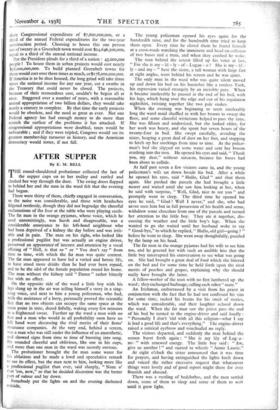HOUSING : AN AMERICAN UTOPIA
By PETER NEUMANN ONE warm day in Washington, D.C., President Roos,- decided that by winter all too many of the nation's population would have no place to lay their heads. He judged this proportion to be " one third of a nation," and the little catch-phrase spread wildly through Federal Press- releases, newspaper and magazine columns, and suddenly bloomed into the title of a popular Federal Theatre Project play. Unfortunately, this publicity was all too good, and a handful of statistics will send the housing boomerang right back to the nation's capital.
To date there have been completed sixty urban housing projects, in 45 American cities (including two in Puerto Rico, three in the Virgin Islands). The bill for 25,000 units (each housing an average of four persons) has come to $125,000,000, or $5,000 per unit. This cost is extremely high, considering that the nation's most highly paid architects can build a dwelling with twice the rooms for a lower cost. The hundred thousand persons now housed in these urban projects will be paying rent for fifteen years before the basic costs of construction are met. Three large rural projects, each a " self-contained " town, have been completed. They sprang up in nineteen months at Greenbelt, Maryland, Greendale, Wisconsin and Greenhills, Ohio, and are collec- tively termed " Greenbelt " towns. Containing 2,100 units in all, the three projects have cost the Federal government $35,000,000, or $16,5oo per unit, which is well over three times the per unit cost of the urban projects. It will take 47 years for the tenants to pay enough rent to meet the original construction costs.
All of these projects were built ostensibly to house what have come to be called the " submerged " groups. But the immense building costs raised the annual income necessary for admittance to an apartment to $1,000, which is two- thirds of the average American income, and over twice that of the submerged group. The urban communities were built to eradicate slums, but wrecking drove the slum-dwellers out of their hovels, into even more squalid quarters, and high rents kept them there. Thus, up to now, American housing has been for the " white collar " group.
There is no question of the urgency of decent housing.
In America's most fertile farm land, the Mississippi Valley, only one farm in ten has electricity or running water. Seventy- two per cent. of the farmers in this Eden exist under the tenant system, in several States bound by law to remain on the land until their debts are paid. This population is increas- ing rapidly, and housing is a more vital problem than ever. But housing is expensive, and rents continue to remain astronomi- cally above entire incomes. A recent study of 12,000 farm families revealed their average worldly goods to be worth three dollars. The highest average farm income in the nation is to be found in the famous Imperial Valley of Cali- fornia, where irrigation and intensive cultivation have per- formed a desert miracle. Yet Greenbelt town rents would consume almost half even of this income.
Employment and wages have sunk together since 1929.
Urban incomes are but slightly higher than rural, and existence depends entirely upon cash income, whereas the farm dweller can often subsist in some way upon his produce, unless his land has been entirely turned over to vital cash crops. In the 3,000 American cities, the housing problem is, if anything, even more urgent than in the country. There are six million Americans on direct dole today, and it is not unsound to suppose that they are inadequately housed in about the same proportion as the rest of the nation is adequately housed. This inadequately housed proportion comprises only 4.6 pi r cent. of the population. Were we to begin all the necessary housing for this group simultaneously, there would be one or more projects in every American city, requiring an imrne- diate Congressional expenditure of $7,600,000,000, or a third of the annual Federal expenditures for the two-year construction period. Choosing to house this one person out of twenty in a Greenbeittown would cost 824,646,500,00o, equal to a third of the annual national income. But the President pleads for a third of a nation : 43,000p00 people ! To house them in urban projects would cost nearly $56,000,000,000. To build planned Greenbelt towns for them would cost over three times as much, or $r 78,000,000,000. If America is to be thus housed, the long grind will take three times the national income for any one year, cut a swathe in the Treasury that could never be closed. The projects, because of their tremendous cost, couldn't be begun all at once. Staggered over a number of years, with a reasonable annual appropriation of two billion dollars, they would take nearly a century to complete. By that time the early projects would be obsolete, and the need as great as ever. Not one Federal agency has had enough money to do more than scratch the surface of the problems it has attacked. If congressional appropriations were doubled, taxes would be unbearable ; and if they were tripled, Congress would see its greatest membership turnover in history, and the American democracy would totter, if not fall.











































 Previous page
Previous page